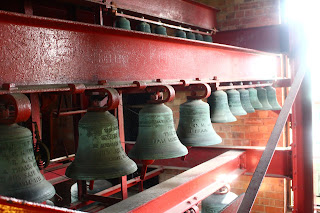Well with our flight back to Canada now booked, we're starting to realize there are even many parts of Loughborough that we haven't explored yet.
This one in particular is not for a lack of trying. We've been to the Loughborough Carillon three times, all of which were closed, and planned to go the day we had to make an emergency drive to Luton so our friend Amy didn't miss her flight.
So despite missing it four times, we realized last Saturday that we had the opportunity, the weather was nice, and we weren't about to miss out again, and off we set.
The Loughborough Carillon is the only purpose built carillon tower in the UK. The other 17 in this country are located in buildings with other purposes (often a church).
The plans for the carillon were initiated in 1919 as a memorial tower to the men of Loughborough (and the UK) who lost their lives fighting in the first world war. The design included three levels for exhibition space, and a lookout balcony for people to see the town from.
Naturally, as you may have seen from other of our posts, there was only one shop in town (mind the pun), or in the UK that would be asked to cast the carillon bells, and that is the John Taylor Bell Foundry, located right here in Loughborough. They have come up a few times over the year we've been here in the UK. This very foundry was called upon to cast the bells in St. Pauls Cathedral, most notably, Great Paul, a 17ton bell. They also cast bells for churches in Cambridge, London, Birmingham, Manchester, even several in Canada (notably the Niagara Falls Rainbow Bridge Carillon). There's a pretty cool (and long) list of their famous noteworthy (i.e. over 2ton) bells here: http://www.taylorbells.co.uk/web/?q=node/60
Anyway, back to the carillon.
So a carillon is actually not the tower, but the instrument. It consists of at least 23 bells, and a control board, modelled like a keyboard or organ (think of the black and white keys, as well as foot pedals), but the 'keys' are struck with the fist. This motion, including the force of the strike, directly activates the bell clapper. Hit the key softer, a quieter ring, hit it hard, and you have a much louder ring.
Wikipedia tells me the carillon is the heaviest musical instrument known to exist.
One of the carillonneurs of the Loughborough Carillon played the instrument for more than 50 years. The current carillonneur is teaching her daughter the skill, so the bells should be ringing in Loughborough for many more years.
The Loughborough carillon is comprised of 47 bells, all cast here in town. The largest weighs more than 4200 kg, while the smallest is a mere 5 kg. Most of the bells were funded by donation from family and friends of those who were lost in the war. As a memorial to their lost loved ones, donations were raised for the construction, and the donor's name's, or tribute, cast into the 47 bells.
In addition to the carillon, there are 3 floors of military memorabilia from the first world war of the various regiments and garrisons in which the residents of Loughborough served. It was really interesting to see various examples of guns, ammunition, shell casings, medals and regimental colours on display.
It was a fairly small part of the exhibit, but Loughborough has a particular notable moment in the first world war.
On the evening of January 31, 1916, a fleet of German zeppelins were spotted off the east coast of the UK. Each one measured more than 200 m in length. Previous attacks had happened on London and along the coast in 1915, but it was generally thought that the midlands, and west coast were out of reach. This night, the alarm was raised in Leicester, and an order for blackout, but not in Loughborough, a town of only 20 000 people. It turns out that the target had been Liverpool and Sheffield, but the zeppelins became lost in the darkness and fog, and upon spotting the lights of what is now 'The Rushes' shopping centre downtown, released the bombs and turned back to the mainland. 10 were killed in Loughborough, and 70 in total throughout the midlands.
While we were in Queens Park, there were three different exhibitions / displays happening (along with about 15 others around town) to mark the centenary of the attack (well a nice summer day near the centenary of the attack).














2 comments:
The Peace Tower Carillon tour will have to be on your agenda for when you get back to Ottawa; my dad always loved that part of the Parliament Building tours with his students. This was the best video clip I could find - https://www.youtube.com/watch?v=qlxfK4Rd31s - they don't mention if the bells are from Loughborough on it but Wikipedia tells me they are from Craydon, UK.
Reminds me of the time I saw a carillonneur play the bells. It's got to be one of the more vigorous instruments to play, too. It's pretty cool to see that the town still has someone to play them. Also, what's that geodesic dome in the park (?) for?
Post a Comment